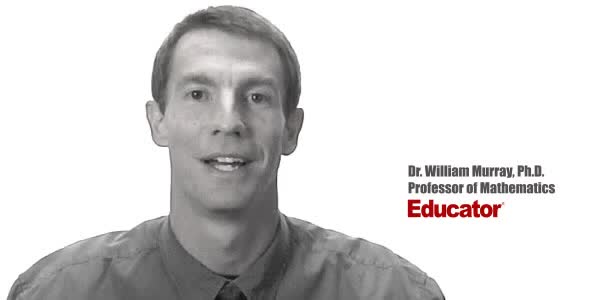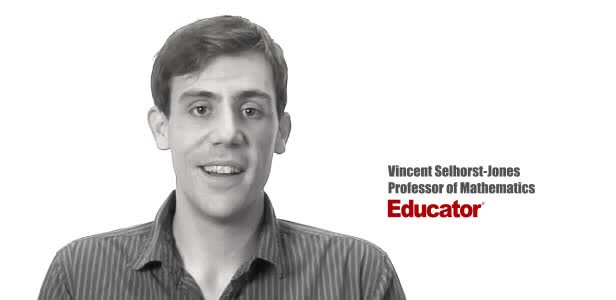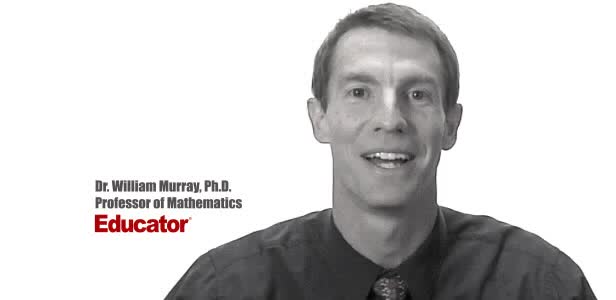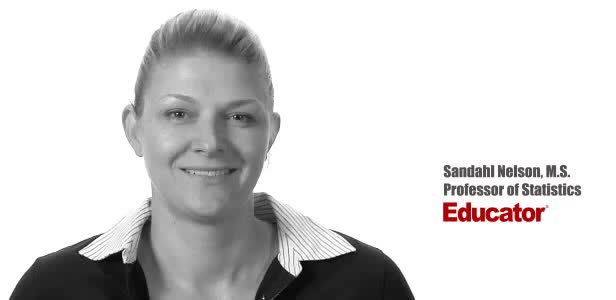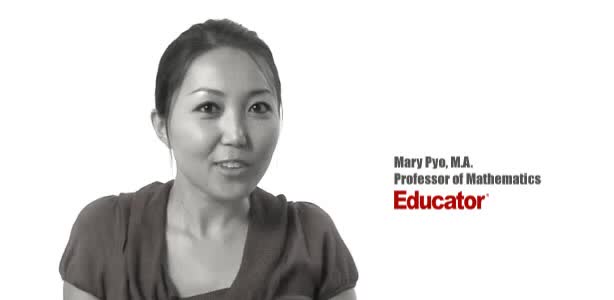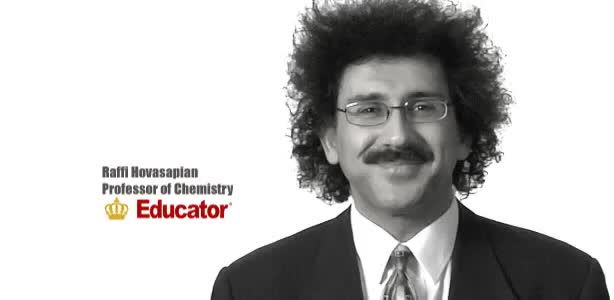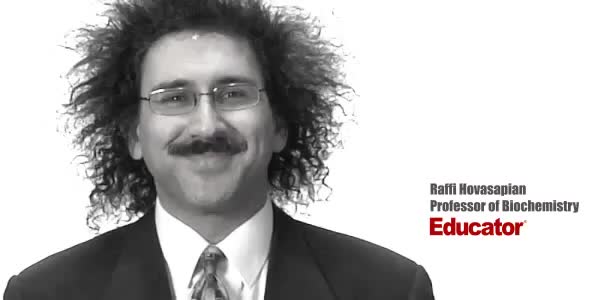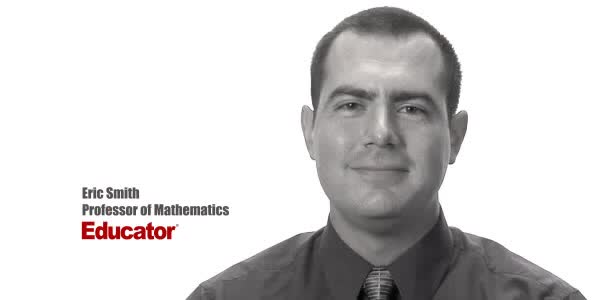Section 1: Vectors |
| |
Points & Vectors |
28:23 |
| | |
Intro |
0:00 | |
| | |
Points and Vectors |
1:02 | |
| | |
| A Point in a Plane |
1:03 | |
| | |
| A Point in Space |
3:14 | |
| | |
| Notation for a Space of a Given Space |
6:34 | |
| | |
| Introduction to Vectors |
9:51 | |
| | |
| Adding Vectors |
14:51 | |
| | |
| Example 1 |
16:52 | |
| | |
| Properties of Vector Addition |
18:24 | |
| | |
| Example 2 |
21:01 | |
| | |
| Two More Properties of Vector Addition |
24:16 | |
| | |
| Multiplication of a Vector by a Constant |
25:27 | |
| |
Scalar Product & Norm |
30:25 |
| | |
Intro |
0:00 | |
| | |
Scalar Product and Norm |
1:05 | |
| | |
| Introduction to Scalar Product |
1:06 | |
| | |
| Example 1 |
3:21 | |
| | |
| Properties of Scalar Product |
6:14 | |
| | |
| Definition: Orthogonal |
11:41 | |
| | |
| Example 2: Orthogonal |
14:19 | |
| | |
| Definition: Norm of a Vector |
15:30 | |
| | |
| Example 3 |
19:37 | |
| | |
| Distance Between Two Vectors |
22:05 | |
| | |
| Example 4 |
27:19 | |
| |
More on Vectors & Norms |
38:18 |
| | |
Intro |
0:00 | |
| | |
More on Vectors and Norms |
0:38 | |
| | |
| Open Disc |
0:39 | |
| | |
| Close Disc |
3:14 | |
| | |
| Open Ball, Closed Ball, and the Sphere |
5:22 | |
| | |
| Property and Definition of Unit Vector |
7:16 | |
| | |
| Example 1 |
14:04 | |
| | |
| Three Special Unit Vectors |
17:24 | |
| | |
| General Pythagorean Theorem |
19:44 | |
| | |
| Projection |
23:00 | |
| | |
| Example 2 |
28:35 | |
| | |
| Example 3 |
35:54 | |
| |
Inequalities & Parametric Lines |
33:19 |
| | |
Intro |
0:00 | |
| | |
Inequalities and Parametric Lines |
0:30 | |
| | |
| Starting Example |
0:31 | |
| | |
| Theorem 1 |
5:10 | |
| | |
| Theorem 2 |
7:22 | |
| | |
| Definition 1: Parametric Equation of a Straight Line |
10:16 | |
| | |
| Definition 2 |
17:38 | |
| | |
| Example 1 |
21:19 | |
| | |
| Example 2 |
25:20 | |
| |
Planes |
29:59 |
| | |
Intro |
0:00 | |
| | |
Planes |
0:18 | |
| | |
| Definition 1 |
0:19 | |
| | |
| Example 1 |
7:04 | |
| | |
| Example 2 |
12:45 | |
| | |
| General Definitions and Properties: 2 Vectors are Said to Be Paralleled If |
14:50 | |
| | |
| Example 3 |
16:44 | |
| | |
| Example 4 |
20:17 | |
| |
More on Planes |
34:18 |
| | |
Intro |
0:00 | |
| | |
More on Planes |
0:25 | |
| | |
| Example 1 |
0:26 | |
| | |
| Distance From Some Point in Space to a Given Plane: Derivation |
10:12 | |
| | |
| Final Formula for Distance |
21:20 | |
| | |
| Example 2 |
23:09 | |
| | |
| Example 3: Part 1 |
26:56 | |
| | |
| Example 3: Part 2 |
31:46 | |
Section 2: Differentiation of Vectors |
| |
Maps, Curves & Parameterizations |
29:48 |
| | |
Intro |
0:00 | |
| | |
Maps, Curves and Parameterizations |
1:10 | |
| | |
| Recall |
1:11 | |
| | |
| Looking at y = x2 or f(x) = x2 |
2:23 | |
| | |
| Departure Space & Arrival Space |
7:01 | |
| | |
| Looking at a 'Function' from ℝ to ℝ2 |
10:36 | |
| | |
| Example 1 |
14:50 | |
| | |
| Definition 1: Parameterized Curve |
17:33 | |
| | |
| Example 2 |
21:56 | |
| | |
| Example 3 |
25:16 | |
| |
Differentiation of Vectors |
39:40 |
| | |
Intro |
0:00 | |
| | |
Differentiation of Vectors |
0:18 | |
| | |
| Example 1 |
0:19 | |
| | |
| Definition 1: Velocity of a Curve |
1:45 | |
| | |
| Line Tangent to a Curve |
6:10 | |
| | |
| Example 2 |
7:40 | |
| | |
| Definition 2: Speed of a Curve |
12:18 | |
| | |
| Example 3 |
13:53 | |
| | |
| Definition 3: Acceleration Vector |
16:37 | |
| | |
| Two Definitions for the Scalar Part of Acceleration |
17:22 | |
| | |
| Rules for Differentiating Vectors: 1 |
19:52 | |
| | |
| Rules for Differentiating Vectors: 2 |
21:28 | |
| | |
| Rules for Differentiating Vectors: 3 |
22:03 | |
| | |
| Rules for Differentiating Vectors: 4 |
24:14 | |
| | |
| Example 4 |
26:57 | |
Section 3: Functions of Several Variables |
| |
Functions of Several Variable |
29:31 |
| | |
Intro |
0:00 | |
| | |
Length of a Curve in Space |
0:25 | |
| | |
| Definition 1: Length of a Curve in Space |
0:26 | |
| | |
| Extended Form |
2:06 | |
| | |
| Example 1 |
3:40 | |
| | |
| Example 2 |
6:28 | |
| | |
Functions of Several Variable |
8:55 | |
| | |
| Functions of Several Variable |
8:56 | |
| | |
| General Examples |
11:11 | |
| | |
| Graph by Plotting |
13:00 | |
| | |
| Example 1 |
16:31 | |
| | |
| Definition 1 |
18:33 | |
| | |
| Example 2 |
22:15 | |
| | |
| Equipotential Surfaces |
25:27 | |
| | |
| Isothermal Surfaces |
27:30 | |
| |
Partial Derivatives |
23:31 |
| | |
Intro |
0:00 | |
| | |
Partial Derivatives |
0:19 | |
| | |
| Example 1 |
0:20 | |
| | |
| Example 2 |
5:30 | |
| | |
| Example 3 |
7:48 | |
| | |
| Example 4 |
9:19 | |
| | |
| Definition 1 |
12:19 | |
| | |
| Example 5 |
14:24 | |
| | |
| Example 6 |
16:14 | |
| | |
| Notation and Properties for Gradient |
20:26 | |
| |
Higher and Mixed Partial Derivatives |
30:48 |
| | |
Intro |
0:00 | |
| | |
Higher and Mixed Partial Derivatives |
0:45 | |
| | |
| Definition 1: Open Set |
0:46 | |
| | |
| Notation: Partial Derivatives |
5:39 | |
| | |
| Example 1 |
12:00 | |
| | |
| Theorem 1 |
14:25 | |
| | |
| Now Consider a Function of Three Variables |
16:50 | |
| | |
| Example 2 |
20:09 | |
| | |
| Caution |
23:16 | |
| | |
| Example 3 |
25:42 | |
Section 4: Chain Rule and The Gradient |
| |
The Chain Rule |
28:03 |
| | |
Intro |
0:00 | |
| | |
The Chain Rule |
0:45 | |
| | |
| Conceptual Example |
0:46 | |
| | |
| Example 1 |
5:10 | |
| | |
| The Chain Rule |
10:11 | |
| | |
| Example 2: Part 1 |
19:06 | |
| | |
| Example 2: Part 2 - Solving Directly |
25:26 | |
| |
Tangent Plane |
42:25 |
| | |
Intro |
0:00 | |
| | |
Tangent Plane |
1:02 | |
| | |
| Tangent Plane Part 1 |
1:03 | |
| | |
| Tangent Plane Part 2 |
10:00 | |
| | |
| Tangent Plane Part 3 |
18:18 | |
| | |
| Tangent Plane Part 4 |
21:18 | |
| | |
| Definition 1: Tangent Plane to a Surface |
27:46 | |
| | |
| Example 1: Find the Equation of the Plane Tangent to the Surface |
31:18 | |
| | |
| Example 2: Find the Tangent Line to the Curve |
36:54 | |
| |
Further Examples with Gradients & Tangents |
47:11 |
| | |
Intro |
0:00 | |
| | |
Example 1: Parametric Equation for the Line Tangent to the Curve of Two Intersecting Surfaces |
0:41 | |
| | |
| Part 1: Question |
0:42 | |
| | |
| Part 2: When Two Surfaces in ℝ3 Intersect |
4:31 | |
| | |
| Part 3: Diagrams |
7:36 | |
| | |
| Part 4: Solution |
12:10 | |
| | |
| Part 5: Diagram of Final Answer |
23:52 | |
| | |
Example 2: Gradients & Composite Functions |
26:42 | |
| | |
| Part 1: Question |
26:43 | |
| | |
| Part 2: Solution |
29:21 | |
| | |
Example 3: Cos of the Angle Between the Surfaces |
39:20 | |
| | |
| Part 1: Question |
39:21 | |
| | |
| Part 2: Definition of Angle Between Two Surfaces |
41:04 | |
| | |
| Part 3: Solution |
42:39 | |
| |
Directional Derivative |
41:22 |
| | |
Intro |
0:00 | |
| | |
Directional Derivative |
0:10 | |
| | |
| Rate of Change & Direction Overview |
0:11 | |
| | |
| Rate of Change : Function of Two Variables |
4:32 | |
| | |
| Directional Derivative |
10:13 | |
| | |
| Example 1 |
18:26 | |
| | |
| Examining Gradient of f(p) ∙ A When A is a Unit Vector |
25:30 | |
| | |
| Directional Derivative of f(p) |
31:03 | |
| | |
| Norm of the Gradient f(p) |
33:23 | |
| | |
| Example 2 |
34:53 | |
| |
A Unified View of Derivatives for Mappings |
39:41 |
| | |
Intro |
0:00 | |
| | |
A Unified View of Derivatives for Mappings |
1:29 | |
| | |
| Derivatives for Mappings |
1:30 | |
| | |
| Example 1 |
5:46 | |
| | |
| Example 2 |
8:25 | |
| | |
| Example 3 |
12:08 | |
| | |
| Example 4 |
14:35 | |
| | |
| Derivative for Mappings of Composite Function |
17:47 | |
| | |
| Example 5 |
22:15 | |
| | |
| Example 6 |
28:42 | |
Section 5: Maxima and Minima |
| |
Maxima & Minima |
36:41 |
| | |
Intro |
0:00 | |
| | |
Maxima and Minima |
0:35 | |
| | |
| Definition 1: Critical Point |
0:36 | |
| | |
| Example 1: Find the Critical Values |
2:48 | |
| | |
| Definition 2: Local Max & Local Min |
10:03 | |
| | |
| Theorem 1 |
14:10 | |
| | |
| Example 2: Local Max, Min, and Extreme |
18:28 | |
| | |
| Definition 3: Boundary Point |
27:00 | |
| | |
| Definition 4: Closed Set |
29:50 | |
| | |
| Definition 5: Bounded Set |
31:32 | |
| | |
| Theorem 2 |
33:34 | |
| |
Further Examples with Extrema |
32:48 |
| | |
Intro |
0:00 | |
| | |
Further Example with Extrema |
1:02 | |
| | |
| Example 1: Max and Min Values of f on the Square |
1:03 | |
| | |
| Example 2: Find the Extreme for f(x,y) = x² + 2y² - x |
10:44 | |
| | |
| Example 3: Max and Min Value of f(x,y) = (x²+ y²)⁻¹ in the Region (x -2)²+ y² ≤ 1 |
17:20 | |
| |
Lagrange Multipliers |
32:32 |
| | |
Intro |
0:00 | |
| | |
Lagrange Multipliers |
1:13 | |
| | |
| Theorem 1 |
1:14 | |
| | |
| Method |
6:35 | |
| | |
| Example 1: Find the Largest and Smallest Values that f Achieves Subject to g |
9:14 | |
| | |
| Example 2: Find the Max & Min Values of f(x,y)= 3x + 4y on the Circle x² + y² = 1 |
22:18 | |
| |
More Lagrange Multiplier Examples |
27:42 |
| | |
Intro |
0:00 | |
| | |
Example 1: Find the Point on the Surface z² -xy = 1 Closet to the Origin |
0:54 | |
| | |
| Part 1 |
0:55 | |
| | |
| Part 2 |
7:37 | |
| | |
| Part 3 |
10:44 | |
| | |
Example 2: Find the Max & Min of f(x,y) = x² + 2y - x on the Closed Disc of Radius 1 Centered at the Origin |
16:05 | |
| | |
| Part 1 |
16:06 | |
| | |
| Part 2 |
19:33 | |
| | |
| Part 3 |
23:17 | |
| |
Lagrange Multipliers, Continued |
31:47 |
| | |
Intro |
0:00 | |
| | |
Lagrange Multipliers |
0:42 | |
| | |
| First Example of Lesson 20 |
0:44 | |
| | |
| Let's Look at This Geometrically |
3:12 | |
| | |
Example 1: Lagrange Multiplier Problem with 2 Constraints |
8:42 | |
| | |
| Part 1: Question |
8:43 | |
| | |
| Part 2: What We Have to Solve |
15:13 | |
| | |
| Part 3: Case 1 |
20:49 | |
| | |
| Part 4: Case 2 |
22:59 | |
| | |
| Part 5: Final Solution |
25:45 | |
Section 6: Line Integrals and Potential Functions |
| |
Line Integrals |
36:08 |
| | |
Intro |
0:00 | |
| | |
Line Integrals |
0:18 | |
| | |
| Introduction to Line Integrals |
0:19 | |
| | |
| Definition 1: Vector Field |
3:57 | |
| | |
| Example 1 |
5:46 | |
| | |
| Example 2: Gradient Operator & Vector Field |
8:06 | |
| | |
| Example 3 |
12:19 | |
| | |
| Vector Field, Curve in Space & Line Integrals |
14:07 | |
| | |
| Definition 2: F(C(t)) ∙ C'(t) is a Function of t |
17:45 | |
| | |
| Example 4 |
18:10 | |
| | |
| Definition 3: Line Integrals |
20:21 | |
| | |
| Example 5 |
25:00 | |
| | |
| Example 6 |
30:33 | |
| |
More on Line Integrals |
28:04 |
| | |
Intro |
0:00 | |
| | |
More on Line Integrals |
0:10 | |
| | |
| Line Integrals Notation |
0:11 | |
| | |
| Curve Given in Non-parameterized Way: In General |
4:34 | |
| | |
| Curve Given in Non-parameterized Way: For the Circle of Radius r |
6:07 | |
| | |
| Curve Given in Non-parameterized Way: For a Straight Line Segment Between P & Q |
6:32 | |
| | |
| The Integral is Independent of the Parameterization Chosen |
7:17 | |
| | |
| Example 1: Find the Integral on the Ellipse Centered at the Origin |
9:18 | |
| | |
| Example 2: Find the Integral of the Vector Field |
16:26 | |
| | |
| Discussion of Result and Vector Field for Example 2 |
23:52 | |
| | |
| Graphical Example |
26:03 | |
| |
Line Integrals, Part 3 |
29:30 |
| | |
Intro |
0:00 | |
| | |
Line Integrals |
0:12 | |
| | |
| Piecewise Continuous Path |
0:13 | |
| | |
| Closed Path |
1:47 | |
| | |
| Example 1: Find the Integral |
3:50 | |
| | |
| The Reverse Path |
14:14 | |
| | |
| Theorem 1 |
16:18 | |
| | |
| Parameterization for the Reverse Path |
17:24 | |
| | |
| Example 2 |
18:50 | |
| | |
| Line Integrals of Functions on ℝn |
21:36 | |
| | |
| Example 3 |
24:20 | |
| |
Potential Functions |
40:19 |
| | |
Intro |
0:00 | |
| | |
Potential Functions |
0:08 | |
| | |
| Definition 1: Potential Functions |
0:09 | |
| | |
| Definition 2: An Open Set S is Called Connected if… |
5:52 | |
| | |
| Theorem 1 |
8:19 | |
| | |
| Existence of a Potential Function |
11:04 | |
| | |
| Theorem 2 |
18:06 | |
| | |
| Example 1 |
22:18 | |
| | |
| Contrapositive and Positive Form of the Theorem |
28:02 | |
| | |
| The Converse is Not Generally True |
30:59 | |
| | |
| Our Theorem |
32:55 | |
| | |
| Compare the n-th Term Test for Divergence of an Infinite Series |
36:00 | |
| | |
| So for Our Theorem |
38:16 | |
| |
Potential Functions, Continued |
31:45 |
| | |
Intro |
0:00 | |
| | |
Potential Functions |
0:52 | |
| | |
| Theorem 1 |
0:53 | |
| | |
| Example 1 |
4:00 | |
| | |
| Theorem in 3-Space |
14:07 | |
| | |
| Example 2 |
17:53 | |
| | |
| Example 3 |
24:07 | |
| |
Potential Functions, Conclusion & Summary |
28:22 |
| | |
Intro |
0:00 | |
| | |
Potential Functions |
0:16 | |
| | |
| Theorem 1 |
0:17 | |
| | |
| In Other Words |
3:25 | |
| | |
| Corollary |
5:22 | |
| | |
| Example 1 |
7:45 | |
| | |
| Theorem 2 |
11:34 | |
| | |
| Summary on Potential Functions 1 |
15:32 | |
| | |
| Summary on Potential Functions 2 |
17:26 | |
| | |
| Summary on Potential Functions 3 |
18:43 | |
| | |
| Case 1 |
19:24 | |
| | |
| Case 2 |
20:48 | |
| | |
| Case 3 |
21:35 | |
| | |
| Example 2 |
23:59 | |
Section 7: Double Integrals |
| |
Double Integrals |
29:46 |
| | |
Intro |
0:00 | |
| | |
Double Integrals |
0:52 | |
| | |
| Introduction to Double Integrals |
0:53 | |
| | |
| Function with Two Variables |
3:39 | |
| | |
| Example 1: Find the Integral of xy³ over the Region x ϵ[1,2] & y ϵ[4,6] |
9:42 | |
| | |
| Example 2: f(x,y) = x²y & R be the Region Such That x ϵ[2,3] & x² ≤ y ≤ x³ |
15:07 | |
| | |
| Example 3: f(x,y) = 4xy over the Region Bounded by y= 0, y= x, and y= -x+3 |
19:20 | |
| |
Polar Coordinates |
36:17 |
| | |
Intro |
0:00 | |
| | |
Polar Coordinates |
0:50 | |
| | |
| Polar Coordinates |
0:51 | |
| | |
| Example 1: Let (x,y) = (6,√6), Convert to Polar Coordinates |
3:24 | |
| | |
| Example 2: Express the Circle (x-2)² + y² = 4 in Polar Form. |
5:46 | |
| | |
| Graphing Function in Polar Form. |
10:02 | |
| | |
| Converting a Region in the xy-plane to Polar Coordinates |
14:14 | |
| | |
| Example 3: Find the Integral over the Region Bounded by the Semicircle |
20:06 | |
| | |
| Example 4: Find the Integral over the Region |
27:57 | |
| | |
| Example 5: Find the Integral of f(x,y) = x² over the Region Contained by r= 1 - cosθ |
32:55 | |
| |
Green's Theorem |
38:01 |
| | |
Intro |
0:00 | |
| | |
Green's Theorem |
0:38 | |
| | |
| Introduction to Green's Theorem and Notations |
0:39 | |
| | |
| Green's Theorem |
3:17 | |
| | |
| Example 1: Find the Integral of the Vector Field around the Ellipse |
8:30 | |
| | |
| Verifying Green's Theorem with Example 1 |
15:35 | |
| | |
| A More General Version of Green's Theorem |
20:03 | |
| | |
| Example 2 |
22:59 | |
| | |
| Example 3 |
26:30 | |
| | |
| Example 4 |
32:05 | |
| |
Divergence & Curl of a Vector Field |
37:16 |
| | |
Intro |
0:00 | |
| | |
Divergence & Curl of a Vector Field |
0:18 | |
| | |
| Definitions: Divergence(F) & Curl(F) |
0:19 | |
| | |
| Example 1: Evaluate Divergence(F) and Curl(F) |
3:43 | |
| | |
| Properties of Divergence |
9:24 | |
| | |
| Properties of Curl |
12:24 | |
| | |
| Two Versions of Green's Theorem: Circulation - Curl |
17:46 | |
| | |
| Two Versions of Green's Theorem: Flux Divergence |
19:09 | |
| | |
| Circulation-Curl Part 1 |
20:08 | |
| | |
| Circulation-Curl Part 2 |
28:29 | |
| | |
| Example 2 |
32:06 | |
| |
Divergence & Curl, Continued |
33:07 |
| | |
Intro |
0:00 | |
| | |
Divergence & Curl, Continued |
0:24 | |
| | |
| Divergence Part 1 |
0:25 | |
| | |
| Divergence Part 2: Right Normal Vector and Left Normal Vector |
5:28 | |
| | |
| Divergence Part 3 |
9:09 | |
| | |
| Divergence Part 4 |
13:51 | |
| | |
| Divergence Part 5 |
19:19 | |
| | |
| Example 1 |
23:40 | |
| |
Final Comments on Divergence & Curl |
16:49 |
| | |
Intro |
0:00 | |
| | |
Final Comments on Divergence and Curl |
0:37 | |
| | |
| Several Symbolic Representations for Green's Theorem |
0:38 | |
| | |
| Circulation-Curl |
9:44 | |
| | |
| Flux Divergence |
11:02 | |
| | |
| Closing Comments on Divergence and Curl |
15:04 | |
Section 8: Triple Integrals |
| |
Triple Integrals |
27:24 |
| | |
Intro |
0:00 | |
| | |
Triple Integrals |
0:21 | |
| | |
| Example 1 |
2:01 | |
| | |
| Example 2 |
9:42 | |
| | |
| Example 3 |
15:25 | |
| | |
| Example 4 |
20:54 | |
| |
Cylindrical & Spherical Coordinates |
35:33 |
| | |
Intro |
0:00 | |
| | |
Cylindrical and Spherical Coordinates |
0:42 | |
| | |
| Cylindrical Coordinates |
0:43 | |
| | |
| When Integrating Over a Region in 3-space, Upon Transformation the Triple Integral Becomes.. |
4:29 | |
| | |
| Example 1 |
6:27 | |
| | |
| The Cartesian Integral |
15:00 | |
| | |
| Introduction to Spherical Coordinates |
19:44 | |
| | |
| Reason It's Called Spherical Coordinates |
22:49 | |
| | |
| Spherical Transformation |
26:12 | |
| | |
| Example 2 |
29:23 | |
Section 9: Surface Integrals and Stokes' Theorem |
| |
Parameterizing Surfaces & Cross Product |
41:29 |
| | |
Intro |
0:00 | |
| | |
Parameterizing Surfaces |
0:40 | |
| | |
| Describing a Line or a Curve Parametrically |
0:41 | |
| | |
| Describing a Line or a Curve Parametrically: Example |
1:52 | |
| | |
| Describing a Surface Parametrically |
2:58 | |
| | |
| Describing a Surface Parametrically: Example |
5:30 | |
| | |
| Recall: Parameterizations are not Unique |
7:18 | |
| | |
| Example 1: Sphere of Radius R |
8:22 | |
| | |
| Example 2: Another P for the Sphere of Radius R |
10:52 | |
| | |
| This is True in General |
13:35 | |
| | |
| Example 3: Paraboloid |
15:05 | |
| | |
| Example 4: A Surface of Revolution around z-axis |
18:10 | |
| | |
Cross Product |
23:15 | |
| | |
| Defining Cross Product |
23:16 | |
| | |
| Example 5: Part 1 |
28:04 | |
| | |
| Example 5: Part 2 - Right Hand Rule |
32:31 | |
| | |
| Example 6 |
37:20 | |
| |
Tangent Plane & Normal Vector to a Surface |
37:06 |
| | |
Intro |
0:00 | |
| | |
Tangent Plane and Normal Vector to a Surface |
0:35 | |
| | |
| Tangent Plane and Normal Vector to a Surface Part 1 |
0:36 | |
| | |
| Tangent Plane and Normal Vector to a Surface Part 2 |
5:22 | |
| | |
| Tangent Plane and Normal Vector to a Surface Part 3 |
13:42 | |
| | |
| Example 1: Question & Solution |
17:59 | |
| | |
| Example 1: Illustrative Explanation of the Solution |
28:37 | |
| | |
| Example 2: Question & Solution |
30:55 | |
| | |
| Example 2: Illustrative Explanation of the Solution |
35:10 | |
| |
Surface Area |
32:48 |
| | |
Intro |
0:00 | |
| | |
Surface Area |
0:27 | |
| | |
| Introduction to Surface Area |
0:28 | |
| | |
| Given a Surface in 3-space and a Parameterization P |
3:31 | |
| | |
| Defining Surface Area |
7:46 | |
| | |
| Curve Length |
10:52 | |
| | |
| Example 1: Find the Are of a Sphere of Radius R |
15:03 | |
| | |
| Example 2: Find the Area of the Paraboloid z= x² + y² for 0 ≤ z ≤ 5 |
19:10 | |
| | |
| Example 2: Writing the Answer in Polar Coordinates |
28:07 | |
| |
Surface Integrals |
46:52 |
| | |
Intro |
0:00 | |
| | |
Surface Integrals |
0:25 | |
| | |
| Introduction to Surface Integrals |
0:26 | |
| | |
| General Integral for Surface Are of Any Parameterization |
3:03 | |
| | |
| Integral of a Function Over a Surface |
4:47 | |
| | |
| Example 1 |
9:53 | |
| | |
| Integral of a Vector Field Over a Surface |
17:20 | |
| | |
| Example 2 |
22:15 | |
| | |
| Side Note: Be Very Careful |
28:58 | |
| | |
| Example 3 |
30:42 | |
| | |
| Summary |
43:57 | |
| |
Divergence & Curl in 3-Space |
23:40 |
| | |
Intro |
0:00 | |
| | |
Divergence and Curl in 3-Space |
0:26 | |
| | |
| Introduction to Divergence and Curl in 3-Space |
0:27 | |
| | |
| Define: Divergence of F |
2:50 | |
| | |
| Define: Curl of F |
4:12 | |
| | |
| The Del Operator |
6:25 | |
| | |
| Symbolically: Div(F) |
9:03 | |
| | |
| Symbolically: Curl(F) |
10:50 | |
| | |
| Example 1 |
14:07 | |
| | |
| Example 2 |
18:01 | |
| |
Divergence Theorem in 3-Space |
34:12 |
| | |
Intro |
0:00 | |
| | |
Divergence Theorem in 3-Space |
0:36 | |
| | |
| Green's Flux-Divergence |
0:37 | |
| | |
| Divergence Theorem in 3-Space |
3:34 | |
| | |
| Note: Closed Surface |
6:43 | |
| | |
| Figure: Paraboloid |
8:44 | |
| | |
| Example 1 |
12:13 | |
| | |
| Example 2 |
18:50 | |
| | |
| Recap for Surfaces: Introduction |
27:50 | |
| | |
| Recap for Surfaces: Surface Area |
29:16 | |
| | |
| Recap for Surfaces: Surface Integral of a Function |
29:50 | |
| | |
| Recap for Surfaces: Surface Integral of a Vector Field |
30:39 | |
| | |
| Recap for Surfaces: Divergence Theorem |
32:32 | |
| |
Stokes' Theorem, Part 1 |
22:01 |
| | |
Intro |
0:00 | |
| | |
Stokes' Theorem |
0:25 | |
| | |
| Recall Circulation-Curl Version of Green's Theorem |
0:26 | |
| | |
| Constructing a Surface in 3-Space |
2:26 | |
| | |
| Stokes' Theorem |
5:34 | |
| | |
| Note on Curve and Vector Field in 3-Space |
9:50 | |
| | |
Example 1: Find the Circulation of F around the Curve |
12:40 | |
| | |
| Part 1: Question |
12:48 | |
| | |
| Part 2: Drawing the Figure |
13:56 | |
| | |
| Part 3: Solution |
16:08 | |
| |
Stokes' Theorem, Part 2 |
20:32 |
| | |
Intro |
0:00 | |
| | |
Example 1: Calculate the Boundary of the Surface and the Circulation of F around this Boundary |
0:30 | |
| | |
| Part 1: Question |
0:31 | |
| | |
| Part 2: Drawing the Figure |
2:02 | |
| | |
| Part 3: Solution |
5:24 | |
| | |
Example 2: Calculate the Boundary of the Surface and the Circulation of F around this Boundary |
13:11 | |
| | |
| Part 1: Question |
13:12 | |
| | |
| Part 2: Solution |
13:56 | |










































